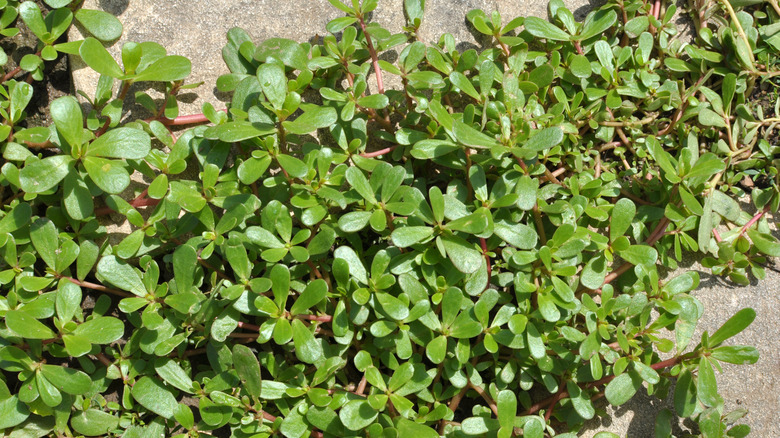Time Is Of The Essence When Treating Aggressive Purslane. Here's Why
While it's true that purslane (Portulaca oleracea) has culinary uses and offers certain health benefits –- such as anti-inflammatory properties and being rich in vitamins, minerals, and omega-3 fatty acids -– it's not the kind of weed you would want to put off removing for later. Its succulent leaves and small yellow flowers may seem innocuous at first glance, but make no mistake –- purslane is a formidable enemy in any garden. This annual weed has a knack for taking over garden beds with its aggressive growth habit and prolific seed production. Purslane's ability to monopolize nutrients and crowd out desirable plants makes it a major headache for gardeners everywhere, so if you find it in your garden, get rid of it ASAP!
A purslane invasion typically begins when seeds are introduced to a new area. Purslane produces copious amounts of tiny seeds. Wind, water, and animals can all carry purslane seeds to new locations. These seeds can find their way into garden beds, cracks in pavement, or any other suitable habitat where they can germinate and grow. They can hitch a ride in soil or gardening mulch that's transported from one location to another. If you happen to add contaminated soil or mulch to your garden, it can introduce purslane seeds along with it. Purslane seeds may also cling to shovels, rakes, or other tools, and be transported to different parts of the garden during routine gardening activities.
The urgency of eliminating purslane
Acting swiftly to eradicate purslane from your garden is crucial for several reasons. Firstly, purslane is a fast-growing weed that can quickly overrun your garden if left unchecked. Its low-growing habit and ability to spread by both seeds and stem fragments make it difficult to control once it establishes a foothold. Purslane seeds can germinate and grow quickly, forming dense mats of vegetation that can smother, crowd, and shade out your garden plants. Without intervention, a purslane invasion can rapidly escalate, making it essential to take proactive measures to prevent and control its spread.
Moreover, purslane's prolific reproductive capacity means that allowing even a few plants to go to seed can result in a significant increase in weed pressure the following season. Mature purslane plants shed up to 50,000 seeds during their lifetime, contributing to the rapid spread of the weed. Its ability to produce thousands of tiny seeds ensures that it can rapidly colonize bare soil and outcompete desirable plants for space, water, sunlight, and nutrients. The seeds can remain viable in the soil for many years, making purslane challenging to control. Purslane can also re-root itself from stem or leaf fragments left in the soil after manual removal, making it more difficult to eradicate. And while you can put purslane in your salad and enjoy it, this weed is toxic to livestock and cats and dogs, as it contains oxalates that can cause gastrointestinal distress and other problems if ingested.
Effective strategies to eliminate purslane and prevent its resurgence
If you want to eliminate purslane for good, you need to adopt a multi-pronged approach to succeed. Hand-pulling can be effective for small infestations, but be sure to remove the entire plant, including the roots, to prevent regrowth. Dispose of the pulled plants properly by putting them in sealed bags, so they won't have an opportunity to grow elsewhere. Mulching garden beds with organic materials (ideally three inches thick) can also help suppress weed growth and create a barrier to prevent purslane seeds from reaching the soil.
You can also pour boiling water directly on the leaves, stems, and roots of the weed, or use a distilled white vinegar and water (1:1 ratio) spray solution with a bit of dish soap mixed in. Spray it over the purslane as needed. Just make sure the boiled water or the vinegar spray doesn't land on any desirable plants in your garden. You can also apply soil solarization to control and get rid of purslane and other weeds in your garden. This method involves the use of solar heat to kill weed seeds and seedlings in the soil. Once you successfully eliminate purslane, regular monitoring and quick action are key to preventing it from reestablishing itself in your garden. By staying vigilant and implementing effective control measures, you can keep purslane out of your lawn and garden effectively.


